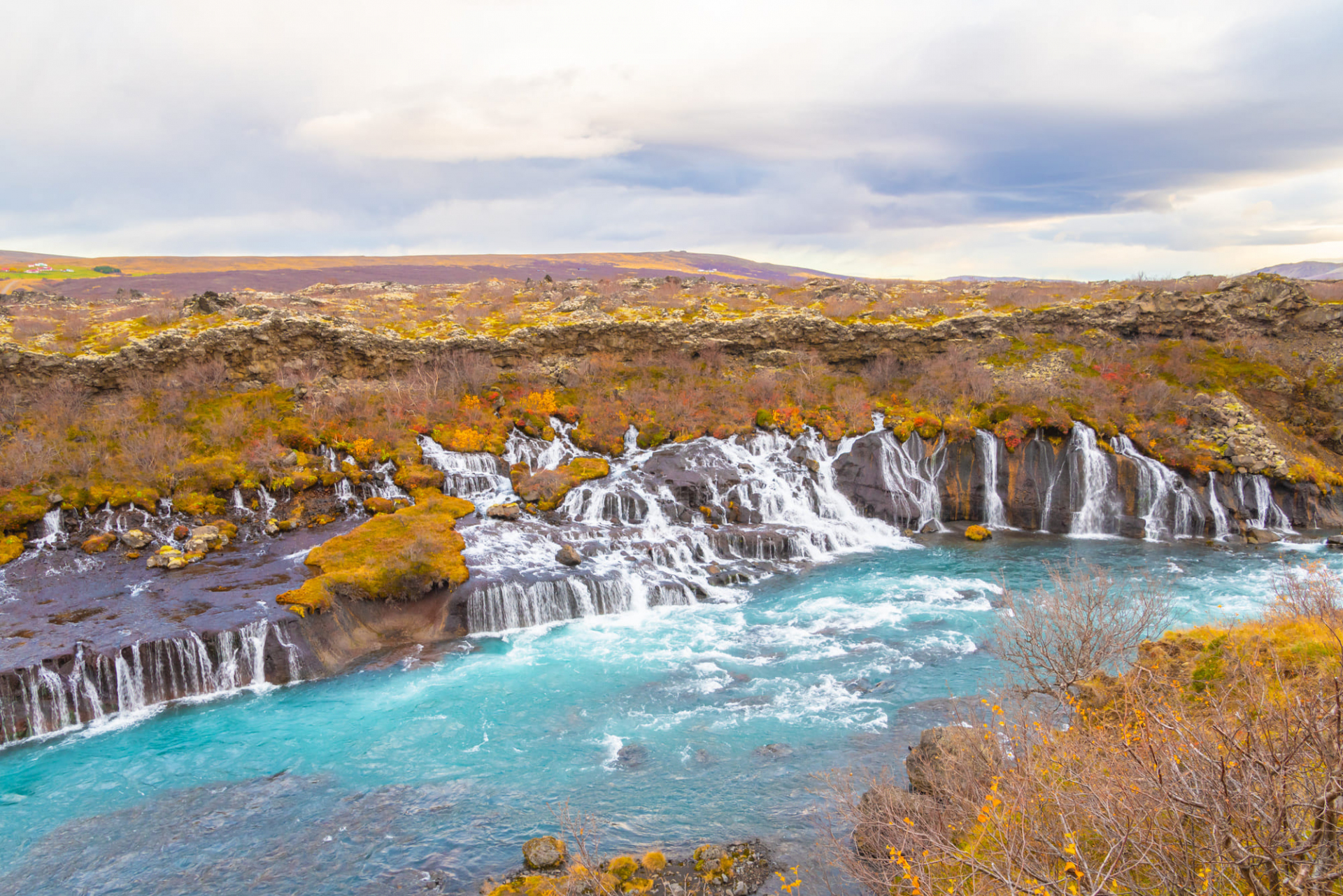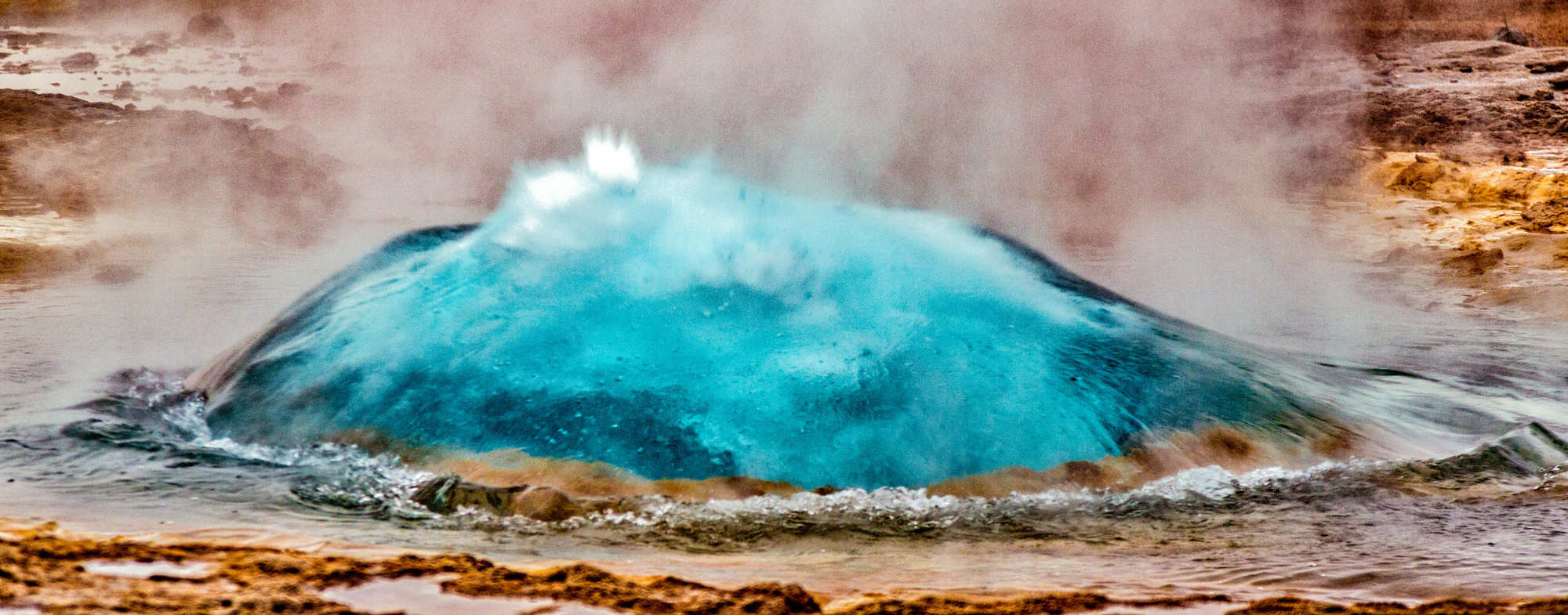
Are you dreaming of discovering Iceland, but don’t know the ideal season or length of time to explore the country? Then take a look at our travel guide, which will help you choose the right tour for you!
Even though most tourists visit Iceland in the summer, Iceland’s winters present a buffet of lights and colours! Because very few people visit in this season, you’ll have a wild ice covered terrain to yourself. Go for hikes on foot, with snowshoes, skis or even sleds to discover the splendour of Iceland’s geothermic and volcanic manifestations. Under the snow, their contrasts become even more fascinating. You are at the heart of Iceland, far from everything.
Thanks to the Gulf Stream, Iceland has a temperate oceanic climate, that shields it from the northern influence of the Arctic currents. Thus, winter in Iceland is not as harsh as it looks when it comes down to it, and the average temperatures are hardly ever below -5°C (23 degrees F), with the exception of the interior of Iceland’s territory whose temperatures can drop to -20 °C (-4 degrees F). The winter nights are long, making this an ideal time to observe the night sky and take in its splendid northern lights. Veils of light composed of millions of green, blue, red and yellow specks, this natural light show begins in September and ends in March. In the day, the sun pops out for a couple of hours showering Iceland in an oblique light that seems more like a long twilight than a sunny day.
As in every northern country, travelling in the winter in Iceland you must consider the length of the days, the average temperatures and the amount of precipitation while organizing your trip. On that note, here is some information and advice that you are sure to find useful:
Iceland’s climate is characterized by sudden changes in weather and temperature. The constant struggle between Greenland’s polar gusts from the north and the hot and humid winds pushed up from the tropics are responsible for its unpredictable nature. In fact, there is an Icelandic proverb that sums this up nicely; “if you don’t like the weather, just wait around five minutes”! For travelling, this means that you should pack wind-breakers, wool sweaters, normal winter attire and of course a bathing suit, to forget about the harshness of winter while soaking in one of Iceland’s innumerable hot springs! Le wind, culprit behind the quickly changing elements, blows hard and often prompts snow and sand storms in Iceland’s interior. Finally, know that while in the northern regions it is often colder, the climate is more humid and temperate in the south.
In December and January, the days get shorter and shorter. Daybreak is around 11:00 in the morning and dusk around 16:45 in the afternoon. It generally pretty snowy everywhere and the average temperature is from -2°C to +2°C (28.4-35.6 degrees F). By February and March, the sun is often shining and the roads begin to become driveable again. The average temperatures now are from -2°C to +4°C (28.4 -39.4 degrees F), with peaks of up to 6°C (42.8). Keep in mind, however, that the wind remains strong, and the humidity in the air can make the air feel colder than it really is. In February daylight goes from 10:00 to 17:30, while March boasts the longest days in winter from 8:30 to 19:00.
During this time of year, since many roads are closed due to snow, the best way to get around Iceland is on the route 1 that goes around the island, and will give you a glimpse of all of Iceland’s dazzling winter landscapes.
In the heart of winter we especially recommend driving along the southern coast of Iceland to the feet of the Vatnajokull glacier. Donning its winter coat, its lagoon is full of icebergs, while its frozen waterfalls and lakes surround you. If you intend to travel north, know that the roads will be snowy making conditions difficult. But if you are in a four wheel drive vehicle and are consulting meteorological reports, you should manage just fine. Finally, for a short break we would recommend visiting Reykjavik’s surroundings, especially Iceland’s famous golden circle, the Snæfellsness peninsula and the Reykjanes peninsula.
Thanks to the currents of the Gulf Stream, Iceland’s climate benefits from a temperate oceanic influence. From June to August, discover the magnificent landscapes that have emerged from beneath the winter snows as the Icelandic nature emerges from its hibernation. During the summer months, migrating birds and marine animals regain the island’s coasts to take advantage of its long sunny days. At the gates of the polar circle, from mid-June to mid-July, the midnight sun, that never really sets, illuminates the bright nights of summer. In Iceland, from the summer solstice (June 21st) onwards, dusk falls at around midnight, and the peculiar clear night only lasts until 3:00 in the morning. At this time, day breaks and offers myriad opportunities for early risers!
The summer is without question the most beautiful season to visit Iceland. The fresh temperatures, radiant skies, and vibrant colours of the season’s natural settings make for ideal hiking conditions. Starting in July, the roads and trails closed during the winter on account of the snow reopen. This allows you to cross the central highlands and discover the untamed regions of the northern fjords. Iceland’s climate is characterized by sudden changes in weather and temperature. The constant struggle between Greenland’s polar gusts from the north and the hot and humid winds pushed up from the tropics are responsible for its unpredictable nature. In fact, there is an Icelandic proverb that sums this up nicely; “if you don’t like the weather, just wait around five minutes”! For travelling, this means that you should pack wind-breakers, wool sweaters, normal winter attire and of course a bathing suit, to forget about the harshness of winter while soaking in one of Iceland’s innumerable hot springs! Le wind, culprit behind the quickly changing elements, blows hard and often prompts snow and sand storms in Iceland’s interior. Finally, know that while in the northern regions it is often colder, the climate is more humid and temperate in the south.
In June the contrasting landscapes are at their most striking, and the weather its most stable. The grass is a rich green and the water from melting snows streams all around you. Most native birds nest during the month of June with its optimal day length. In this month rain is rare, and the sunshine is almost constant. Average temperatures stay between 7°C and 12°C (44.6-53.6 degrees F).
In July, the weather fluctuates more and rainfall is more frequent. The average temperatures will for the most part drift between 9°C to 14°C (48.2-57.2 degrees F) with occasional peaks of 20°C (68 degrees F). All the roads and trails that cross the country are now open for travel. In the middle of summer, lakes and cliffs are covered with birds. The summer season has reached its climax and all mountain huts, hostels, hotels museums and guesthouses are open for business and welcoming tourists and travellers. Because of this, it is wise to book things in advance (accommodations, activities, etc.).
The August temperatures are the same as those of July, but the weather is more stable. This is a pleasant period as the days are still long but there are already less tourists. The winged traffic on the cliffs also dissipates as migrating birds take off for their long journeys south in search of warmer temperatures. At the end of the month, real nights return, lasting from 22:00 to 5:00. The northern lights season begins in September and lasts through March, but if you’re exceedingly lucky, you may spot some in the end of August.
We’d like to let you in on a little secret; travel in Iceland is magical year-round! For people who want to avoid the season of high tourist flow (June-August) and who are afraid of harsh winter conditions, spring and autumn are great times to visit Iceland. During these seasons we would particularly recommend the Skaftafell National Park. A natural marvel, its panoramas are magnificent when painted with their spring and autumn colours!
In autumn, the days remain long and the temperatures more than manageable. September is the month during which the night sky begins to display its famous northern lights. A blanket of illuminations made up of thousands of shades of green, blue, red and yellow, this magnetic phenomenon lasts until the end of the winter. In September, the temperatures drift between 6°C and 11°C (42.8-51.8 degrees F). At night, meanwhile, they can drop down to 0°C (32 degrees F), so campers be warned! Dusk is around 20:30, and daybreak around 6:15. Iceland’s vegetation remains lush, its colours veer towards those of autumn and its wild lands have become deserted by tourists for your personal enjoyment. In October, the progression towards winter becomes more marked. For the most part, the average temperatures stay between 3°C and 7°C (37.4-44.6 degrees F); while icy nights last from about 18:30 to 8:00 in the morning. By now, several hotels and mountain huts will have closed for the low season, some roads will be closed off, and many bus routes will no longer run. Things to keep this in mind when organizing your trip.
Travelling in Iceland in the spring is the perfect opportunity to watch the land emerge from idle hibernation back to bustling life. Still blanketed in snow, the terrain allows for observation of stunning landscapes of a wild nature in the midst of its seasonal rebirth. The temperatures and meteorological conditions start to become more hospitable. In April, temperatures stay on the positive side, anywhere from 1°C to 6°C (33.8-42.8 degrees F). The sun rises at 6:30 and sets around 20:35. Snow everywhere becomes patchy as it melts away, and most roads reopen for travel. The roads through the central highlands, however, stay closed until the month of July. This is because Iceland’s interior remains covered in snow until the beginning of summer. The month of May, with a pleasantly low tourist flow, is brighter, sunnier and less rainy. The average temperatures are still relatively crisp, between 4°C to 12°C (39.2 -53.6 degrees F), and the sun lasts from 4:30 until 22:00. Throughout Iceland, the hostels, hotels and museums that were closed during low season reopen their doors to travellers.
